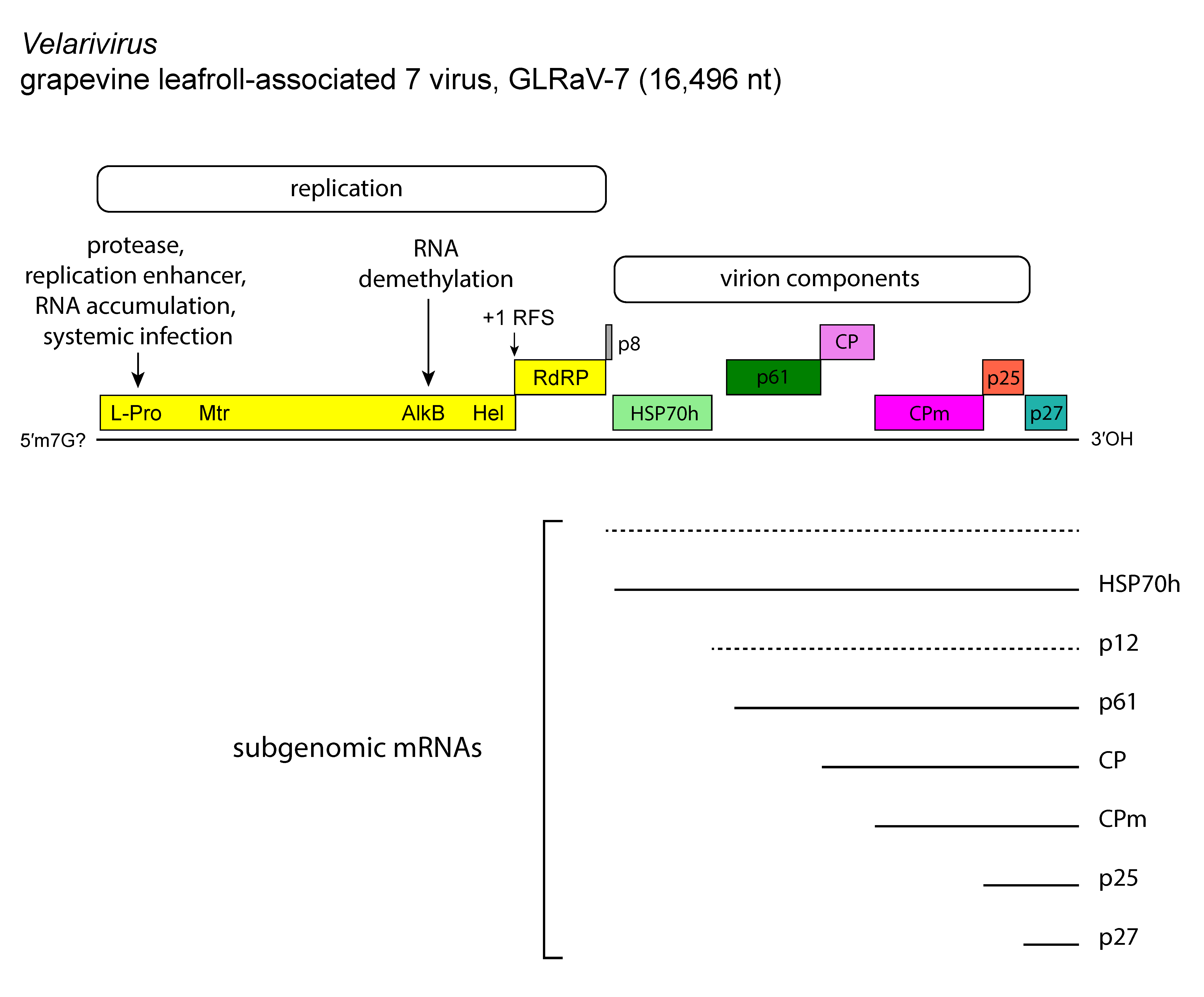Family: Closteroviridae
Genus: Velarivirus
Distinguishing features
The genus comprises species whose members have virion particles of 1,500 to 1,700 nm in length, a positive-sense, single-stranded RNA genome of 16–16.9 kb, and no known insect vector.
Virion
Morphology
See discussion under family description.
Physicochemical and physical properties
See discussion under family description.
Nucleic acid
Virions contain a single molecule of linear, positive-sense, single-stranded RNA of 16,080 to 16,934 nt.
Proteins
Structural proteins consist of a coat protein (CP) and a minor CP (CPm), with masses ranging from 34 to 46 kDa (CP) and 69 to 76 kDa (CPm), according to species.
Lipids
None reported.
Carbohydrates
None reported.
Genome organization and replication
Little cherry virus 1 (LChV-1) has the largest genome reported for the genus at 16,934 nt (isolate UW2) and contains nine ORFs coding for the replication associated proteins [ORF 1a with a L-Pro, a methyltransferase (Mtr) and a helicase (Hel); and ORF1b with an RNA-directed RNA polymerase (RdRP)], a small hydrophobic protein (4–8 kDa) with a transmembrane domain, the HSP70h, the ~60 kDa protein, coat protein (CP), minor coat protein (CPm), and two additional proteins of 25 and 27 kDa. The genome of grapevine leafroll-associated virus 7 (GLRaV-7), a member of the type species of the genus, is of 16,496 nt (isolate Swi) and has nine ORFs encoding structural and non-structural proteins (Figure 1. Velarivirus) similar in type and function to those of LChV-1 (Al Rwahnih et al., 2012).
 |
|
Figure 1. Velarivirus. Genome organization of grapevine leafroll-associated virus 7 (GLRaV-7), a member of the type species of the genus Velarivirus, showing the relative position of the open reading frames and their expression products: UTR, untranslated region; L-Pro, papain-like protease; Mtr, methyltransferase; Hel, helicase; RdRP, RNA-directed RNA polymerase; HSP70h, heat shock protein 70 homolog; ~60 kDa protein; CP, coat protein; CPm, minor coat protein. |
Biology
Velariviruses infect primarily woody hosts, in which they induce no apparent symptoms. No insect vector is known for any of the members of the genus. None of the viruses is transmitted through seed or mechanically. Geographical distribution varies from restricted (e.g. areca palm velarivirus 1, ArPV1) to wide (LChV-1).
Antigenicity
Antisera have been raised from purified virions of a few velariviruses. There are no detectable serological relationships between members of different species.
Species demarcation criteria
The criteria demarcating species in the genus are:
- Particle size.
- Size of CP, as determined by deduced amino acid sequence data.
- Serological specificity using discriminatory monoclonal or polyclonal antibodies.
- Genome structure and organization (number and relative location of the ORFs).
- Amino acid sequence of relevant gene products (RdRP, CP, HSP70h) differing by more than 25%.
- Magnitude and specificity of natural host range.
- Cytopathological features (i.e., aspect of inclusion bodies and origin of cytoplasmic vesicles).

